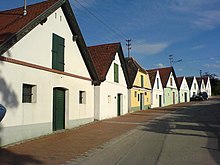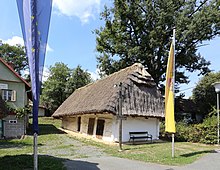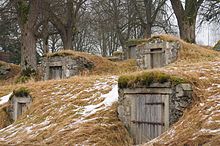Basement lane
The term Kellergasse , also known as the cellar drift , is mainly used in Austria and describes the alleyway , which is often a ravine , especially in wine-growing regions , on which the wine cellars and press houses are located. In some cases, the cellars are not located along a street, but in the form of a pile outside of a town, here we speak of cellar district .
General
A distinction is made between cellar lanes in which the cellars are only on one side of the path (single-line cellar lane) and those (often in sunken paths) with cellars on both sides of the path (two-line cellar lane). In the vernacular, the Kellergasse is often referred to as the “ village without a chimney ”.
The cellar lanes are almost exclusively in the Weinviertel (the north-eastern part of Lower Austria ) and the adjacent areas in the Czech Republic as well as in Burgenland , the border area in Hungary , and occasionally in Slovenia in Franconia . They are extremely rare elsewhere. In the individual cellars, the winemakers often meet for a drink and / or to check the progress of the vinification and the quality of the wine . In the past, women were usually only found in cellars during the grape harvest . In the meantime the job description has changed and there are more and more well-known winemakers.
Smaller, mostly centuries-old cellars were often driven into the mountain in the wine-growing areas outside the village. The plants, which are often close to one another, usually have a press house just below ground level. This is connected by a so-called cellar neck with the actual storage cellar further back .
In areas with predominant loess soil , the cellar alleys are mostly designed as steep-walled hollow paths . Only the cellar entrances are visible towards the alley. In loess or similarly manageable soils, earth stalls are sometimes discovered during renovation or expansion work .
The cellar lanes and their press houses represent a cultural asset worth preserving . Therefore, many press houses are listed .
In the cellar lanes there are also often smaller wine bars and guesthouses . The wine festivals in the cellar lanes are also known beyond the borders of Austria.
People who lead tourists through cellar lanes are called cellar lane guides . The training to become a cellar lane guide goes back to a regional initiative in the Lower Austrian Weinviertel and takes place in six modules, whereby the topics architecture , tourism , wine , history , communication and practice are taught. The first course was held in 2000.
History and creation
The history of the cellar lanes in their current form begins around the 17th century, even if there have been separate places for pressing and storing wine since the beginning of viticulture.
In ancient Rome, the forerunners of our press houses, in which the grapes are pressed, were known as "torcularia" or "calcatoria". The storage took place in "celleae vinariae", depressions with wooden planks, in which amphorae with a capacity of up to 30 liters were buried in the ground up to the neck. Tacitus reports that the Germans had underground storage rooms where wine was stored. Until around the year 800 such storage and utility rooms were mostly made of wood, only later did they gradually replace the underground storage rooms made of stone.
Because press houses and the production of wine were reserved for monasteries and the authorities for centuries, reading houses and large toe cellars were mainly located in monasteries and towns as well as near the manorial vineyards from the Middle Ages to modern times . In the year 885 a press house was first mentioned as part of a farm in the course of a foundation near Krems . Separate storage rooms were not required for the wine produced in-house.
After the Thirty Years War, the farmers received more vineyards and needed new storage space. Up to the year 1800 more and more wine cellars were laid out and whole cellar lanes with their now well-known wine cellars gradually developed.
Cellar alleys in Austria
Burgenland
For Burgenland, cellar quarters are more typical than cellar lanes. Cellar lanes are mainly located in the north (in the Neusiedl am See district , the landscape of which merges into bordering Lower Austria), but the Edelstal in the far north also has a cellar district. Well-known cellar lanes are for example in Purbach am Neusiedler See or in Breitenbrunn am Neusiedler See with the "Drachkeller" built by surgeon Anton Drach in 1866 , which houses an extensive exhibition. A well-known cellar district is located in Heiligenbrunn , where more than 100 cellars are under monument protection for about 2 kilometers (see list of listed objects in Heiligenbrunn ). Kellergassen and cellar districts occur in two separate regions in Burgenland: on the one hand in the area around Lake Neusiedl , on the other hand in southern Burgenland (districts of Oberwart and Güssing ).
Often the buildings in the basement lanes in Burgenland are only press houses without access to a storage cellar, such as in Heiligenbrunn.
Lower Austria
In Lower Austria there are around 1100 cellar lanes in 181 communities. Well-known cellar lanes in the Weinviertel are, for example, the Öhlbergkellergasse in Pillersdorf , the Zipf in Mailberg , where 21 adjacent press houses are listed (see list of listed objects in Mailberg ) and the Gstetten in Poysdorf . In order to make the preservation of the Kellergasse more attractive, a Kellergasse of the year is chosen every year . The longest cellar lane in the world is the one in Hadres with a length of 1,600 meters and 400 cellars and press houses.
- See also: All cellar lanes at a glance (
 map with all coordinates: OSM)
map with all coordinates: OSM)
Upper Austria
There is a cellar lane with 26 earth cellars in a ravine in Raab , see monument protection .
Styria
Cellar lanes like in Fehring and Glanz an der Weinstrasse bear witness to the ancient winemaking tradition in the south-east Styrian hill country.
Cellar alleys in the Czech Republic (South Moravia)
There are two cellar lanes in the Nový Šaldorf-Sedlešovice municipality , and wine cellars with baroque gables can be found in Pavlov u Dolních Věstonic . The cellars in Bořetice are arranged in two “main streets” (Horní and Dolní Frejd), and finally there is also a cellar street in Prušánky .
See also: Lists of cellar streets in the Mikulov , Slovácko , Velké Pavlovice and Znojmo wine regions
Cellar streets in Hungary
Cellar lanes can be found in western Hungary, for example in Villány , Pécs or Sátoraljaújhely .
Cellar alleys in Germany
Francs
Cellar alleys are a characteristic of Franconia. The regional main areas of distribution in Bavaria are in Upper , Lower and Middle Franconia . The Bavarian center of the Kellergassen is in the Dogger and Sandstein Keuper area. However, the creation of cellar alleys was not necessarily linked to this geological formation . For example, there are remarkable cellars in the Weißenstadt area, which used to be over 200 individual cellars. The Weißenstädter Kellerwelt is located in the granite rock of the Fichtelgebirge . Well-developed cellar lanes have also been preserved in Deusdorf and Priegendorf in the Bamberg district . On the outskirts of Unterhaid , one of the largest and best-preserved cellar lanes in Franconia has been restored.
Cellar lanes, consisting of numerous individual cellars, were preferably laid out on steep slopes near ravines or on bouncing slopes of flowing waters. The north side of the slopes facing away from the sun was preferred and planted with deciduous trees for better shade. Linden ( Tilia ) and horse chestnut (Aesculus hippocastanum) were mainly used, and occasionally common locust tree ( Robinia pseudoacacia) and real walnut ( Juglans regia ). The entrances, enclosed in sandstone or brickwork, were characterized by a rectangular or round-arched shape.
The Franconian cellar lanes often contain up to 50 individual cellars and were built to store fruit, vegetables, meat as well as beer and wine. Due to the consistently low temperature between 6 and 10 degrees Celsius in the cellars, the food has a longer shelf life all year round. The increasing use of potatoes as the staple food in Franconian cuisine created the need for cooler storage areas. In addition, the conversion of the brewing system to storable bottom-fermented beer also played a decisive role in the need for rock cellars. The more storable beers could be kept for up to ten months with appropriate storage. In the Bamberg area as well as in the area around Forchheim and Erlangen , the installation of rock cellars was closely linked to the brewing industry, mostly peasant house breweries.
The elaborate construction of the cellars was uneconomical in the rural areas of Franconia until the 18th century. That is why the rock cellars in these regions were mostly not built until the 19th century. In Weißenstadt in the district of Wunsiedel , rock cellars were built as early as the late Middle Ages as part of mining in the Fichtel Mountains. They were also built as refuge during the Thirty Years War . Many cellars of the residential buildings were still connected to one another in the historic town centers in modern times.
Many rock cellars were abandoned after the Second World War. The refrigerator took over its function. Over half of the Franconian rock cellars is in decline. Illegal garbage dumps often impair the appearance of the historical cultural landscape selemente.
Rheinhessen
There are also similar wine cellars in Rheinhessen , for example the Guntersblumer Kellerweg and the Westhofener Kellergasse.
Trivia
Kellergassen in Pulkautal served as the setting in the Polt novels of Alfred Komarek .
literature
- Günter Fuhrmann, Wolfgang Galler: Keller.Kultur.Erbe From the first wine cellar to the cellar lanes in the Weinviertel, Driesch Verlag, Drösing 2017, ISBN 978-3-902787-46-0
- Wolfgang Krammer, Johannes Rieder: Immortal cultural treasure. Weinviertler Kellergassen, Edition Winkler-Hermaden, Schleinbach 2012, ISBN 978-3-9503151-7-2
- Helmut Leierer, future of Kellergassen. Building design, Österreichischer Agrarverlag 2004/2008, ISBN 3-7040-2088-5
- Kultur der Kellergasse , issue 4/5 of the series Das Weinviertel , self-published by Kulturbund Weinviertel, Mistelbach 1980
- History and creation of the Kellergassen by Horst Krönigsberger, published by the European Regional Development Fund, accessed on July 19, 2014
Movie
- Kellergassen in Lower Austria , documentation by Georg Riha (2014)
Individual evidence
- ↑ a b c Historical cultural landscape elements in Bavaria. In: Bavarian State Office for the Environment (Hrsg.): Heimatpflege in Bayern. Series of publications by the Bavarian State Association for Homeland Care . 1st edition. tape 4 , 2013, ISBN 978-3-931754-54-9 , pp. 104 f .
- ↑ Fürnkranz Rudolf: Weinviertel. Questions about the history of the Weinviertel, the village communities, viticulture, the cellar lanes, p. 15–16 ( Memento of the original from September 18, 2013 in the Internet Archive ) Info: The archive link was automatically inserted and not yet checked. Please check the original and archive link according to the instructions and then remove this notice. Retrieved July 19, 2014
- ↑ Fürnkranz Rudolf: Weinviertel. Questions about the history of the Weinviertel, the village communities, viticulture, the cellar lanes, p. 16 ( Memento of the original from September 18, 2013 in the Internet Archive ) Info: The archive link was automatically inserted and not yet checked. Please check the original and archive link according to the instructions and then remove this notice. Retrieved July 19, 2014
- ↑ Breitenbrunn in the online travel guide “Neusiedlersee” ( memento of the original from July 27, 2014 in the Internet Archive ) Info: The archive link was inserted automatically and has not yet been checked. Please check the original and archive link according to the instructions and then remove this notice. Retrieved July 19, 2014
- ↑ Galgenberg is the first “Kellergasse of the Year” on ORF on July 23, 2013, accessed on July 24, 2013.
- ↑ Weinstrasse in the Weinviertel ( Memento of the original from October 12, 2013 in the Internet Archive ) Info: The archive link was inserted automatically and has not yet been checked. Please check the original and archive link according to the instructions and then remove this notice. Retrieved from Weinviertel.at on September 11, 2013
- ↑ End of renovation in Felsenkeller Unterhaid. German Foundation for Monument Protection, April 3, 2014, accessed on October 10, 2018 .
- ↑ In the footsteps of Polt in the Pulkautal ( Memento of the original from October 12, 2013 in the Internet Archive ) Info: The archive link has been inserted automatically and has not yet been checked. Please check the original and archive link according to the instructions and then remove this notice. Retrieved from the Weinviertel portal on September 11, 2013
- ↑ Kellergassen in Lower Austria on the 3sat website , accessed on March 2, 2015.






